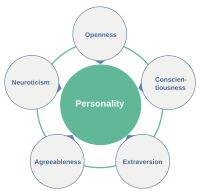
Photo from wikipedia
Modern selection approaches are expected to bring about the cumulative and permanent improvement of animal performance and profitability of animal production. Breeding values of traits along with trait economic values… Click to show full abstract
Modern selection approaches are expected to bring about the cumulative and permanent improvement of animal performance and profitability of animal production. Breeding values of traits along with trait economic values (EVs) are utilised for economic selection purposes with many species all over the world. Currently, some challenges related to trait EVs in animal breeding should be considered. First, the selection response based on the higher accuracy of genomic selection may be reduced due to improper weighting of the trait breeding values of selection candidates. A comprehensive approach applied in bioeconomic models allows suitable trait EV calculations. Further challenges comprise the new breeding objectives associated with climate change, environmental mitigation and animal adaptability. The estimation of EVs for traits influencing greenhouse gas (GHG) emissions has been mostly based on including the value of CO2 emission equivalent in the trait EVs, on calculating EVs for feed efficiency traits and on methane yield as a direct trait of GHG emission. Genetic improvement of production, functional, feed efficiency and methane traits through the application of multi-trait selection indices was found to be crucial for mitigation of emissions and farm profitability. Defining the non-market values of traits connected with climate protection could be a useful solution for including these traits in an economic breeding objective. While GHG emissions mostly change the costs per unit of production, animal adaptability in its complexity influences animal performance. Clear definitions of disease, fertility, mortality and other breeding objective traits allow the proper calculation of trait EVs, and an accurate estimation of trait genetic parameters could lead to sufficient economic selection response. This complex approach could be beneficial for more effective utilisation of inputs and overall economic and environmental sustainability of animal production.
Journal Title: Czech Journal of Animal Science
Year Published: 2020
Link to full text (if available)
Share on Social Media: Sign Up to like & get
recommendations!